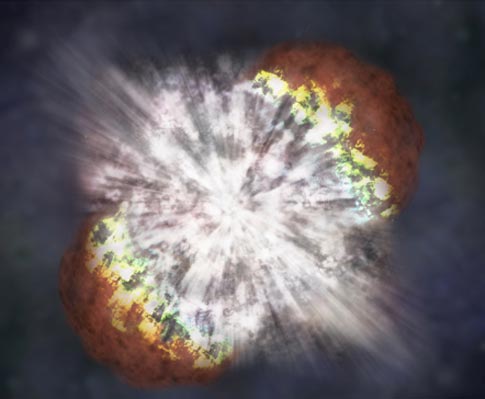A Los Alamos National Laboratory astrophysicist and his colleagues have discovered that a super-bright supernova observed last year might have exhibited an unusual one-two punch.
Alexander Heger of the Theoretical Astrophysics Group in Los Alamos joined University of California Santa Cruz researcher Stan Woosley and Russian researcher Sergei Blinnikov in developing a new model for supernovae behavior that matches observations of supernova SN 2006gy, which exploded last year in a flash 100 times brighter than typically observed in supernovae.
The research team posits that the brilliant flash of light emanating from the star did not come during a single collapse that resulted in the death of the star-the standard model for typical supernovae behavior. Instead, the team has shown that extremely massive supernovae can produce brilliant bursts of light after shedding shells of material that collide with one another, in a manner that more easily converts the kinetic energy of the lost material into light.
The mechanism for this behavior occurs in gigantic stars with masses 100 to 130 times greater than our Sun.
When these huge stars reach the end of their lives, their cores are so hot that they produce pairs of electrons and their anti-matter counterparts, called positrons. The energy lost in making these particles leads to instability in the star and it begins to collapse rapidly. The collapse, in turn, ignites rapid nuclear burning inside the star. The collapse eventually reverts into a powerful thermonuclear explosion that ejects into space material equivalent to tens of solar masses. This ejected shell of material produces only a faint burst of light.
After this first shell is ejected, the process of contraction and explosion begins again and another shell of material is ejected. This time, however, the second shell slams into the first, converting the kinetic energy of all the material into light-producing an extraordinarily brilliant flash, like the one observed in SN 2006gy.
“If you went back and looked at the observations of SN 2006gy prior to last year, you might see a first supernova that was very faint,” said Heger. “The recent flash was probably a second pulse that created the very bright supernova event.”
While previous research has suggested instability of electron-positron pairs leading to supernovae behavior, the study is the first time research has suggested that such repeated instability in pulses creates very bright supernovae. With this new model, multiple pulses of varying strengths are possible, giving rise to a wide variety of behaviors in massive stars until they unleash their final knockout punch.










